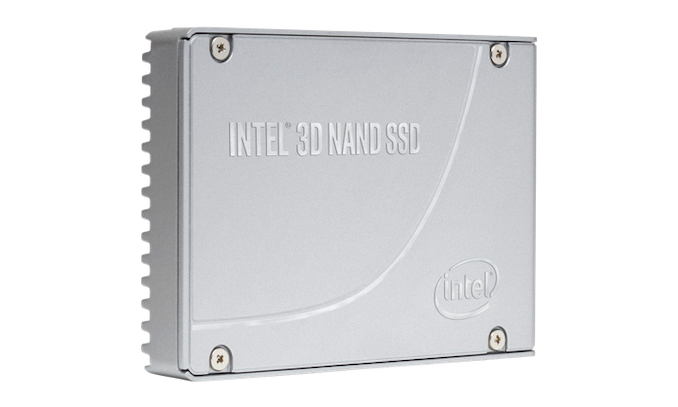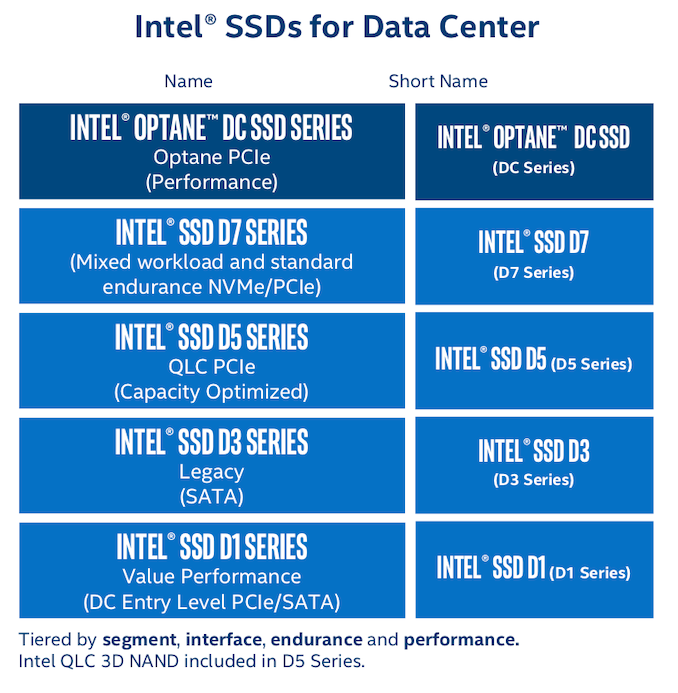Intel Announces D7-P5500 and D7-P5600 Series PCIe 4.0 Enterprise SSDs
by Billy Tallis on June 18, 2020 9:00 AM EST
Intel has yet to launch their first CPUs supporting PCIe 4.0, but other parts of the business are keeping pace with the transition: network controllers, FPGAs, and starting today, SSDs. The first PCIe 4.0 SSDs from Intel are based on their 96-layer 3D TLC NAND flash memory, slotting into Intel's product line just below Optane products and serving as Intel's top tier of flash-based SSDs. The new Intel D7-P5500 and D7-P5600 are codenamed Arbordale Plus, a codename Intel revealed last fall without providing any other information except that the original Arbordale product was never released.
The two new SSD product lines are the first to fall into the D7 tier under the new naming scheme adopted by Intel in 2018. The P5500 and P5600 are closely-related products that differ primarily in their overprovisioning ratios and consequently their usable capacities, write speed and write endurance. The P5500 is the 1 drive write per day (DWPD) lineup with capacities ranging from 1.92 TB up to 7.68 TB, while the P5600 is the 3 DWPD tier with capacities from 1.6 TB to 6.4 TB. These serve as the successors to the P4510 and P4610 Cliffdale Refresh drives, and as such we expect some follow-on models to introduce the EDSFF form factor options and QLC-based drives that are still due for an update.
| Intel PCIe 4.0 Enterprise SSDs | |||
| D7-P5500 | D7-P5600 | ||
| Form Factor | U.2 2.5" 15mm | ||
| Interface | PCIe 4.0 NVMe 1.3c | ||
| Capacities | 1.92TB, 3.84TB, 7.68TB |
1.6TB, 3.2TB, 6.4TB |
|
| NAND | Intel 96L 3D TLC | ||
| Sequential Read | 7000 MB/s | ||
| Sequential Write | 4300 MB/s | ||
| Random Read (4 kB) | 1M IOPS | ||
| Random Write (4 kB) | 130k IOPS | 260k IOPS | |
| Power | Operating | 20 W | |
| Idle | 5 W | ||
| Write Endurance | 1 DWPD | 3 DWPD | |
| Warranty | 5 years | ||
The switch to PCIe 4.0 enables a big jump in maximum throughputs supported: from 3.2 GB/s up to 7 GB/s for sequential reads, while sequential writes show a more modest increase from 3.2 GB/s to 4.3 GB/s. Random reads now hit 1M IOPS compared to about 651k IOPS from the previous generation, and random writes are still bottlenecked by the flash itself with a peak of 260k IOPS from the new P5600.
Intel hasn't shared information about the internal architecture of the new SSDs, so we don't know if they're still using a 12-channel controller design like their previous generation. Intel does tout improved QoS and a handful of new features, including a re-working of their TRIM implementation to reduce its interference with the performance of more important IO commands.











35 Comments
View All Comments
Korguz - Thursday, June 18, 2020 - link
yea ok.. care to share when you got this ? oh wait, you cant.schujj07 - Thursday, June 18, 2020 - link
Same place s/he gets all his/her information...his/her a$%PeachNCream - Thursday, June 18, 2020 - link
No Intel! Just no! The ONLY storage standard that should be in use today is eMMC as we all know full well that is the best option for anything from one of those creeper watches that monitors your biometrics for Google to a facility sized Top 100 list supercomputer. In fact, we should be using eMMC as a RAM interface so we can get rid of HBM, GDDR, and DDR iterations. The world needs fewer traces and Intel has NOT been helping.trivik12 - Thursday, June 18, 2020 - link
Is the controller internal or 3rd party. Plus does Intel have MLC models as well or are all SSD's only TLC.Billy Tallis - Thursday, June 18, 2020 - link
Intel develops their own controllers for their enterprise SSDs, and only uses third-party controllers for consumer drives. Their last MLC enterprise drives were a few models with their first-generation 32-layer 3D NAND. All the P4xxx SSDs were TLC or QLC (Or Optane).boeush - Thursday, June 18, 2020 - link
In terms of write endurance, when you have a 2+ TB drive rated for 1 DWPD, the need for MLC diminishes rapidly unless your workload literally has you pounding the drive with 2+ TB of writes every single day for years on end. For most use cases (with a few relatively exotic exceptions), that's not really the case...The only other advantage of MLC would be faster programming times (i.e. higher write performance), but another way to improve that is to just use more dies/channels to spread the writes across.
olafgarten - Sunday, June 21, 2020 - link
It's a new Intel controller, and I don't think any of their Data Center SSDs are MLC, only TLC or QLC on some models.Ahnilated - Friday, June 19, 2020 - link
I don't see pricing information or availability. That is what disappoints me. Release this information without what really matters.PeachNCream - Saturday, June 20, 2020 - link
Although AT does not always get pricing information from companies for new products and that is disappointing, that really only applies to consumer products. Enterprise hardware almost never has a listed price since purchases are usually done in large quantities typically negotiated between buyer and seller on an individual basis using a supply contract.eastcoast_pete - Friday, June 19, 2020 - link
How about this for a wild rumor, without any evidence in my possession: SONY's PS5 (the one with the really fast SSD) might use an Intel-designed fast SSD controller. Let the rumor mill go wild...